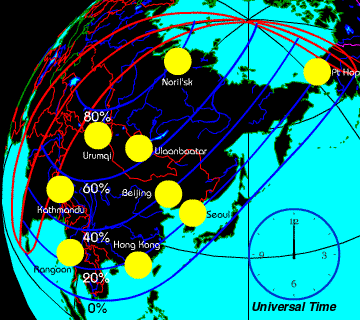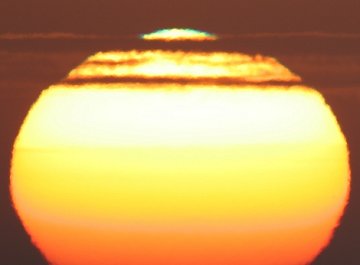 The space shuttle flies in April. Would you like a call when it soars over your backyard? Spaceweather PHONE!
The space shuttle flies in April. Would you like a call when it soars over your backyard? Spaceweather PHONE!
PLUTO OCCULTATION: On Sunday morning, March 18th, Pluto will pass directly in front of a star in the constellation Sagittarius. This occultation will be visible through large backyard telescopes in the western United States, offering a rare look into Pluto's surprising atmosphere. Experienced amateur astronomers are encouraged to observe.
SOLAR ECLIPSE: Longing to visit Siberia in winter? This Monday, March 19th, would be a great day to go. At 0232 UT, the Moon will pass in front of the Russian sun, producing a partial solar eclipse:

Eclipse visibility map. Credit: Larry Koehn of ShadowandSubstance.com
Although the eclipse will be deepest (80%) over Siberia, it will be seen mostly in populous China, where 20% to 40% of the sun will be covered. One way to observe: use a safe solar telescope. Another way: look for crescent-shaped shadows on the ground. [more]
Stay tuned for photos on March 19th!
TURQUOISE SUNRISE: On March 10th in Borken, Germany, photographer Günther Strauch woke up early to enjoy the sunrise--and he's glad he did. The rising sun let loose a cascade of green, blue and turquoise flashes. "Very nice!" he says.

Photo details: Canon EOS 20D, 1/160 to 1/4000 sec exposure, 100 ASA.
"There is a lot going on in this sunrise," explains atmospheric optics expert Les Cowley. "The color bands across the disk show that we are seeing it through multiple layers of air with temperature inversions. As the top of the sun rises through each layer, light from the edge is miraged and vertically magnified into green and blue flashes."
"The green flash of folklore happens once at an ocean surface. This one, a mock-mirage, can be seen flashing several times as the sun rises." More images: #1, #2, #3, #4.

